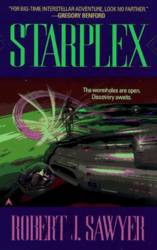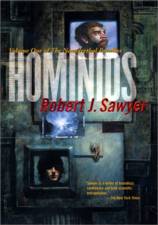

| Robert J. Sawyer has his own Web site (and dig the URL!). | ||
| Click on a book's image or title to order from Amazon.com |

Starplex
Ace, © 1996, 289 pp, ISBN #0-441-00372-9Reviewed February 1997
This book was nominated for the 1997 Hugo Award for best novel.
Starplex starts out feeling like nothing so much as a Star Trek story: A large spaceship, staffed with representatives of three different planets, explores the galaxy under the banner of the Commonwealth. Small matter that the ship - named Starplex - lacks the military muscle of the Enterprise, or that interstellar travel is accomplished primarily through a grid of "shortcuts" through space-time - shortcuts whose origin is mysterious to our heroes. It's still got Television Space Opera written all over it.
The novel takes a turn for the harder variety of SF about a third of the way through, when the crew discovers a swarm of gas-giant-planet-sized entities floating near a recently-activated shortcut, who turn out to be composed of dark matter. As if that isn't enough, the shortcut then activates again, and a large burst of green light shoots from the opening. A very large burst - and getting larger. Someone is sending a star through the shortcut! A green star. But stars aren't green, are they? No, not now; not for a few billion more years. And these things are popping out of shortcuts throughout the galaxy. Hmm.
Starplex also takes the interesting narrative tack of revealing in the prologue that the ship's captain, Keith Lansing, will soon be introduced to the people who constructed the shortcuts; this is actually rather heartening, since it seems common for SF novels of the "humanity discovers ancient alien artifacts whose builders have disappeared" variety often never deliver their payoff, and Sawyer tells you right up-front that you're not going to be cheated in that way.
The story's plot revolves around three elements: Conflict among the three races - humans, Waldahud (short, obnoxious pig-like creatures) and Ib ("Integrated Bioentities", a collective organism); the mysteries of the shortcuts and the star, and Lansing's own mid-life crisis. The novel is therefore decidedly packed with plot, subplot, and counter-plot. Sawyer actually juggles it all rather well, and turns it into a nice roller-coaster ride, with some interesting scientific extrapolations involving immortality and the ultimate fate of the universe.
The novel often lapses into exposition, which works sometimes (as when Sawyer is presenting his more fantastic scientifictional notions) and not others (the seemingly-endless descriptions of the nuts-and-bolts of Starplex and her crew complement). Lansing's personal crises seem a little too simplistically presented, but within their own context I was satisfied with them.
In the end, Starplex comes off a little too "feelgood" for my tastes (it ends with an effort to provide basic philosophical validation for humanity's existence), but it has some awfully exciting - and good - segments. Despite its flaws, it's an awful lot of fun.

Hominids
Tor, HC, © 2002, 448 pp, ISBN #0-312-87692-0Reviewed April 2002
First, a disclaimer: I read this novel in serialized form in the January-to-April 2002 issues of Analog magazine. If the published novel version is different, I don't know how.
Hominids is a parallel-worlds story: Ponter Boddit and his partner Adikor Huld have developed a quantum computer, but something goes wrong and Ponter is thrown into our world. Unfortunately, Ponter is a Neanderthal, whereas we are Homo Sapiens. Although he's largely shielded and befriended by a group of benevolent scientists in Canada, and his high-tech wrist companion can help translate between languages, Ponter is alone and a subject of media and governmental scrutiny.
Meanwhile, Adikor is charged with having murdered Ponter. There's no body, but there doesn't need to be. All of Ponter's people are constantly monitored through their companions, but the experiment was carried out deep below ground, where the companions cannot transmit to the archiving facility. The accuser - the woman-mate of Ponter's woman-mate - believes Adikor, who has a history of violent tendencies, brought Ponter there to murder him and get away with it, and Adikor has a hard time defending himself, even with the help of Ponter's elder daughter.
Hominids' strengths are the portrayal of the neanderthal culture and its people. With their great strength, violence is absolutely outlawed in their world, and those convicted of it are sterilized, as is anyone sharing half their genetic make-up. With their large noses, they can smell things that we can't. And they've developed a culture which largely separates men from women, primarily to control the size of their population. As a result, almost everyone is somewhat bisexual. Combined with the technology of the companions, it seems an idyllic place. And Adikor, ironically, has to demonstrate that what happened underground was not a locked-room murder.
The book's weakness is mainly that it's a fairly pedestrian story. It's an exploration of two cultures and how they differ, which is interesting but not gripping. It's a simple story, simply told; indeed, it reminds me of nothing so much as some of Isaac Asimov's writing. The trial of Adikor often seems somewhat contrived (Adikor is prohibited from returning to the underground cavern, for reasons that seem good on the surface, but which should have been fairly easily circumvented), and other than that there's fairly little tension in the story.
There's also a subplot with a female scientist who is raped early in the story, and works through the impact the rape has on her through her friendship with Ponter. I found the themes surrounding their relationship to be extremely unsubtle and often rather tedious. The whole subplot could have been easily excised with little damage to the book as a whole.
Hominids has some things to recommend it, but it's not crucial reading. It feels like a thriller with more ideas but fewer thrills. Apparently it's the first of a series, but I probably won't stick around for the ride.
hits since 13 August 2000.